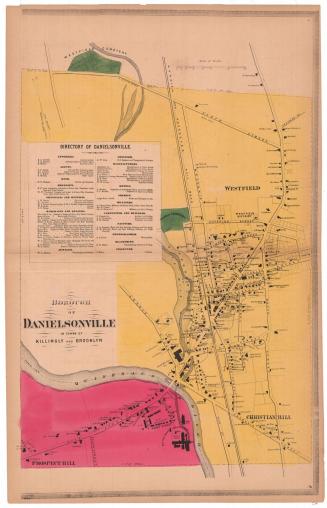Town of Killingly
SurveyorSurveyed by
Ormando Willis Gray
(American, born 1829)
PrinterPrinted by
Kellogg & Bulkeley
(American, 1867 - 1990)
PublisherPublished by
C. G. Keeney
(American, about 1810 - 1888)
Date1869
MediumLithography; black printer's ink and watercolor on wove paper
DimensionsPrimary Dimensions (image height x width): 27 5/8 x 17 7/8in. (70.2 x 45.4cm)
Sheet (height x width): 28 1/2 x 18 1/4in. (72.4 x 46.4cm)
ClassificationsGraphics
Credit LineConnecticut Museum of Culture and History collection
Object number2006.126.0
DescriptionMap of Killingly, Connecticut, from Putnam to the north, Rhode Island to the east, Plainfield and Sterling to the south, and the Quinebaug River, Pomfret and Brooklyn to the west. Killingly is divided into eighteen numbered districts and the borough of Danielsonville. Roads are shown but not labeled, and buildings are marked with a black square and the owner or occupant's name. An unnamed railroad runs north-south through the town. Natural features depicted include elevation, conveyed through hachure marks, ponds, rivers, and brooks. Inset maps show Dayville, Nashawaug water power estate, Williamsville, and Chestnut Hill. At the top of the sheet are directories for Dayville, Williamsville, Chestnut Hill and South Killingly.
Label TextThis map shows a number of mill villages in the town of Killingly in the Quinnebaug River Valley. A "proposed railroad," which would have connected with the Norwich & Worcester Railroad, was apparently never built. This map was part of an atlas of Windham and Tolland Counties printed and published in Hartford in 1869. The atlas was apparently not a success, since the surveyor soon moved on to Philadelphia, and the publisher is not known to have issued any other maps or atlases. The printer, Kellogg & Bulkeley, occasionally printed maps for local customers on into the twentieth century.
NotesCartographic Note: Scale: 1 inch equals 160 rodsStatus
Not on view










